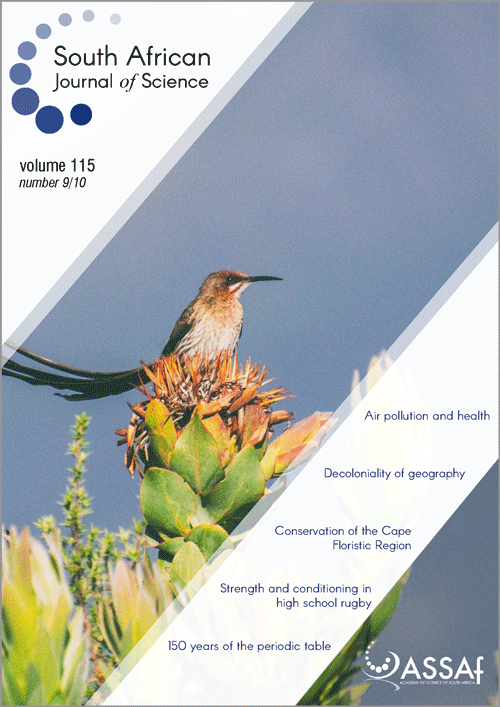Identifying research questions for the conservation of the Cape Floristic Region
DOI:
https://doi.org/10.17159/sajs.2019/5889Keywords:
Fynbos biome, environmental sustainability, Mediterranean-type ecosystem, IPBES Conceptual FrameworkAbstract
We conducted a survey among people working in the nature conservation community in an implementation, research or policy capacity to identify research questions that they felt were important for ensuring the conservation of the Cape Floristic Region. Following an inductive process, 361 submitted questions were narrowed to 34 questions in seven themes: (1) effective conservation management; (2) detecting and understanding change: monitoring, indicators and thresholds; (3) improving governance and action for effective conservation; (4) making the case that biodiversity supports critical ecosystem services; (5) making biodiversity a shared concern; (6) securing sustainable funding for biodiversity conservation; and (7) prioritising research. The final questions were evaluated against the Intergovernmental Science-Policy Platform on Biodiversity and Ecosystem Services Conceptual Framework to test whether the questions addressed elements identified by this Framework as those essential to ensure that conservation contributes to a positive future for the Cape Floristic Region. We found that all elements in this Framework received attention from the collective group of questions. This finding suggests that the conservation community we approached recognises implicitly that research in multiple disciplines as well as interdisciplinary approaches are required to address societal, governance and biological issues in a changing environment in order to secure the conservation of the Cape Floristic Region. Because the majority of people responding to this survey had a background in the natural sciences, a challenge to tackling some of the questions lies in developing integrative approaches that will accommodate different disciplines and their epistemologies.
Significance:
- We present a hierarchical compendium of research questions to generate the knowledge required to conserve the Cape Floristic Region as a social-ecological system.
- The conservation community of the Cape Floristic Region collectively recognises that effective conservation management needs to be supported by knowledge of ecosystems, factors that impact them and context appropriate conservation approaches. In addition, knowledge to develop effective governance and institutions, sustainable funding and broader societal participation in conservation are also identified.
- The questions reflect the elements and linkages of the Intergovernmental Science-Policy Platform on Biodiversity and Ecosystem Services Conceptual Framework, suggesting that the questions presented follow global prerogatives for developing a sustainable future.
- The range and complexity of knowledge gaps presented suggest the need for a broader research agenda that includes the social sciences and humanities to address conservation in the Cape Floristic Region.
Open data set:
Published
Issue
Section
License

All articles are published under a Creative Commons Attribution 4.0 International Licence
Copyright is retained by the authors. Readers are welcome to reproduce, share and adapt the content without permission provided the source is attributed.
Disclaimer: The publisher and editors accept no responsibility for statements made by the authors
How to Cite
- Abstract 1737
- PDF 952
- EPUB 257
- XML 435













.png)